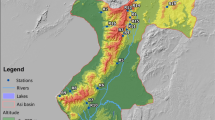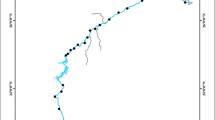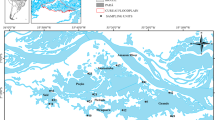Abstract
The aim of the study was to compare the biological analyzes of the Linda River (Central Poland), which were based on three diatom indices: IO, GDI and IPS in order to select the best diatom index for the biological assessment of the lotic water quality. Additionally, the summary of the selected results of the biological and chemical analyzes was presented to show how precise the biological analyzes are as a basic tool in the assessment of the ecological status of the lotic waters. The results showed that each of the indices assessed the water in the Linda River to a specific but different quality class. The IO index showed class II of the water quality, while the IPS and GDI — class III. Statistical analysis conducted with the nonparametric Kruskal-Wallis test for independent samples (Kruskal, Wallis 1952) showed that differences in the values of individual indices at different sites were not statistically significant. It should be noticed that the IPS and GDI indices gave values that classify the water in the Linda River at least one class below. The obtained results confirmed that the biological methods are most reliable in the assessment of the water quality. These methods are less sensitive to a single impact of the environmental factors, therefore they permit accurate determination of the ecological status of the water ecosystems.
Similar content being viewed by others
References
Bathurst, R.R., Zori D. & Byock J. (2010). Diatom as bioindicators of site use: locating turf structures from the Viking Age. J. of Archaeol. Sci. 37: 2920–2928.
Blanco, S., Cejudo-ueiras, C., Tudesque, L., Bécares, E., Hoffmann L. & Ector L. (2012). Are diatom diversity indices reliable monitoring metries? Hydrobiol. 695: 199–206.
Bogaczewicz-Adamczak, B. & Dziengo M. (2003). Using benthic diatom communities and diatom indices to assess water pollution in the Pucka Bay (Southern Baltic Sea) littoral zone. Oceanol. St., 32(4): 131–157.
Bogaczewicz-Adamczak, B. & Koźlarska I. (1999). The evaluation of water quality in the Swelina Stream on the basis of diatom analysis. Oceanol. St. 28(1–2): 59–71.
Bogaczewicz-Adamczak, B., Kłosińska, D. & Zgrundo A. (2001). Diatoms as indicators of water pollution in the coastal zone of the Gulf of Gdańsk (southern Baltic Sea). Oceanol. St. 30(3–4): 59–75.
Burchard, J., Hereźniak-Ciotowa U. & Kaca W. (1990). Metody badańi ocena jakości wód powierzchniowych i podziemnych [The methodology and the assessment of the quality of surface and underground waters]. Łódź: University of Lodz Publisher. [in Polish].
CEMAGREF. (1982). Etude des méthodes biologiques d’appréciation quantitative de la qualité des eaux. [A study on the biological methods of qualitative assessment of water quality. A report of the Water Quality Division Lyon-Outflow Rhône River section catchment] Rapport Division Qualite des Eaux Lyon-A.F. Bassin Rhône-Méditerranée-Corse, Pierre-Bénite, 218 pp. [in French]
Cholnoky, B.J. (1968). Die Ökologie der Diatomeen in Binnengewässer [Ecology of Diatoms in Inland Waters]. J. Cramer Verl., 699 pp. [in German]
Coste, M. & Ayphassorho H. (1991). Etude de la qualité des eaux du bassin Artois Picardie à l’aide des communautés de diatomées benthiques (Application des indices diatomiques), Rapport Cemagref Bordeaux — Agence de l’Eau Artois Picardie, 227 pp. [in French]
Dell’Uomo, A. (2004). L’indice Diatomico di Eutrofizzazione/Polluzione (EPI-D) nel Monitoraggio Delle Acque Correnti. Linee guida. A. P. A. T., A. R. P. A. T., 101 pp. [in French]
Descy, J. P. & Ector L. (1996). Use of diatoms for monitoring rivers in Belgium and Luxemburg. In J. Prygiel, B. A. Whitton & J. Bukowska (Eds.), Use of algae for monitoring rivers III. Agence de l` Eau Artois-Picardie: 128–137.
Dumnicka, E., Jelonek, M., Kwandrans, J., Wojtal, A. & Żurek R. (2006). Ichtiofauna i status ekologiczny wód Wisły, Raby, Dunajca i Wisłoki. [Ichthyofauna and ecological status of the waters of the Vistula, Raba, Dunajec and Wisłoka]. Kraków: Institute of Nature Conservation, Polish Academy of Sciences, 220 pp. [in Polish]
Ector, L. & Rimet F. (2005). Using bioindicators to assess rivers in Europe: an overview. In S. Lek, M. Scardi, P.F.M. Verdonschot, J.P. Descy & Y.S. Park (Eds.), Modelling Community Structure in Freshwater Ecosystems. Springer: Berlin: 7–19.
Eloranta, P. & Soininen J. (2002). Ecological status of some Finnish rivers evaluated using benthic diatoms communities. J. Appl. Phycol. 14: 1–7.
European Union (2000). Directive 2000/60/EC of the European Parliament and of the Council of 23 October 2000 establishing a framework for community action in the field of water policy. Official Journal of the European Communities L327: 1–73.
Gomez, N. & Licursi M. (2001). The Pampean Diatom Index (IDP) for assessment of rivers and stream in Argentina. Aquat. Ecol. 35: 173–181.
Harding, W. R., Archibald, C. G. M. & Taylor J. C. (2005). The relevance of diatoms for water quality assessment in South Africa: A position paper. Water S.A. 31: 41–46.
Hofmann, G. (1994). Aufwuchs — Diatomeen in Seen und ihre Eignung als Indikatoren der Trophie. Bibl. Diatomol., 30: 241 pp.
Kawecka, B. & Eloranta P. V. (1994). Zarys ekologii glonów wód słodkich i środowisk lądowych [An outline of the ecology of freshwater algae and terrestrial environments]. PWN. Warszawa: 251 pp. [in Polish]
Kelly, M. G. & Whitton B. A. (1995). The trophic Diatom Index: a new index for monitoring eutrophication in rivers. J. Appl. Phycol. 7: 433–444.
Kelly, M. G. (2003). Short term dynamics of diatoms in an upland stream and implications for monitoring eutrophication. Environ. Pollut.. 125: 117–122.
Kelly, M. G., Juggins, S., Guthrie, R., Pritchard, S., Jamieson, J., Rippey, B., Hirst, H. & Yallop M. (2008). Assessment of ecological status in U. K. rivers using diatoms. Freshwater Biology. 53: 403–422.
Kruskal, W. H. & Wallis W. A. (1952). Use of ranks in one-criterion variance analysis. J. Amer. Statist. Assoc. 47: 583–621.
Kwandrans, J., Eloranta, P., Kawecka, B. & Wojtan K. (1999). Use of benthic diatom communities to evaluate water quality in rivers of southern Poland, In J. Prygiel, B. A. Witton & J. Bukowska (Eds.), Use of algae for monitoring rivers III (pp. 154–156) Agence de l’Eau Artois-Picardie.
Lange-Bertalot, H. (1979a). Pollution tolerance of diatoms as a criterion for water quality estimation. Nowa Hedwigia 64: 285–304.
Lange-Bertalot, H. (1979b). Toleranzgrenzen und Populationsdynamik benthischer Diatomeen bei unterschiedlich starker Abwassebelastrung. Arch. Hydrobiol. Suppl. 56. Algol. Stud. 23: 184–219.
Lenoir, A. & Coste M. (1996). Development of a practical diatom index of overall water quality applicable to the French National Water Board network. In B.A. Whitton & E. Rott (Eds.). Use of Algae for Monitoring River II, (pp. 29–45) Universität Innsbruck
Nurlimann, J. & Niederhauser P. (2006). Methoden zur Untersuchung und Beurteilung der Fliessgewasser: Kieselalgen Stufe F (flachendeckend) Bundesamt fur Umwelt. BAFU, Bern. [in German]
Picińska-Fałtynowicz, J. (1998). Ocena stopnia czystości wód Kaczego Potoku w Gdyni w oparciu o zbiorowiska okrzemek epilitycznych [The assessment of the degree of water purity in the Kaczy Potkok in Gdynia based on the epilithic diatom communities]. In Streszczenie konferencyjne XVII Sympozjum Sekcji Fykologicznej PTB: Szczecin-łukęcin, 21. [in Polish].
Picińska-Fałtynowicz, J. (2006). Epilithic diatom communities and their indicative value of streams of Sudety Mts. (SW Poland). In E. Acs, T. Kiss, J. Padisak. & E. Szabo (Eds.), 6th International Symposium: Use of Algae for Monitoring Rivers (pp. 109–113). Program, Abstract & Extended Abstracts. Hungarian Algological Society God Hungary.
PB 108 edition No. 3 of 20 September (2011). Badanie zawartości azotu Kjeldahla [The research of the Kjeldahl nitrogen content]. [in Polish].
PN-EN 25813 (1997). Jakość wody. Oznaczanie tlenu rozpuszczonego. Metoda jodometryczna [Water quality. Determination of the dissolved oxygen. Iodimetric method]. [in Polish].
PN-EN 1484 (1999). Analiza wody — Wytyczne oznaczania ogólnego węgla organicznego (OWO) i rozpuszczonego węgla organicznego (RWO) [Water analysis — Guidelines for the determination of total organic carbon (TOC) and dissolved organic carbon (DOC)]. [in Polish].
PN-EN ISO 13395 (2001). Jakość wody — Oznaczanie azotu azotynowego i azotanowego oraz ich sumy metodą analizy przepływowej (CFA i FIA) z detekcją spektrometryczną [Water quality — Determination of the nitrite nitrogen and nitrate nitrogen and their sum by the flow analysis method (CFA and FIA) with the spectrometric detection]. [in Polish].
PN-EN ISO 15681-2 (2002). Jakość wody. Oznaczanie ortofosforanów i fosforu ogólnego metodą analizy przepływowej (FIA i CFA). Część 2: Metoda przepływowej analizy ciągłej (CFA) [Water quality. Determination of the of orthophosphate and total phosphorus by flow analysis method (FIA and CFA). Part 2: Method of the continuous flow analysis (CFA). [in Polish].
PN-EN 18991-2 (2002). Jakość wody. Oznaczanie biochemicznego zapotrzebowania tlenu po n dniach (BZTn). Część 1: Metoda rozcieńczania i szczepienia z dodatkiem allilomocznika. Część 2: Metoda do próbek nie rozcieńczonych [Water quality. Determination of the biochemical oxygen demand after n days (BOD). Part 1: Method of dilution and vaccination with the addition of allyl urea. Part 2: Method for the undiluted samples]. [in Polish].
PN-ISO 5667-6 (2003). Jakość wody. Pobieranie próbek. Część 6: Wytyczne dotyczące pobierania próbek z rzek i strumieni [Water quality. Sampling. Part 6: Guidance on the sampling at rivers and streams]. [in Polish].
PN-EN ISO 11885 (2009). Jakość wody — Oznaczanie wybranych pierwiastków metodą optycznej spektrometrii emisyjnej z plazmą wzbudzoną indukcyjnie (ICP-OES) [Water quality — Determination of the selected elements by the optical emission spectrometry with inductively coupled plasma (ICP-OES)]. [in Polish].
Potapova, M., Charles, D.F., Ponader, K. C. & Winter D. M. (2004). Quantifying species indicator values for trophic diatom indices: comparison of approaches. Hydrobiol. 517: 25–41.
Potapova, M. & Charles D.F. (2005). Choice of substrate in algae-based water-quality assessment. J. N. Am. Benthol.. Soc. 24: 415–427.
Potapova, M. & Charles D.F. (2007). Diatom metrics for monitoring eutrophication in river of the United States. Ecol. Indic. 7: 48–70.
Prygiel, J. & Coste M. (1999). Progress in the use of diatoms for monitoring rivers in France. In J. Prygiel, B. A. Whitton & J. Bukowska (Eds.), Use of algae for monitoring rivers III (pp. 165–179) Agence de l’Eau Artois-Picardie.
Prygiel, J. 2002. Mangement of the diatom monitoring network in France. J. Appl. Phycol. 14: 19–26.
Rakowska, B. (2000). Qualitative assessment of water in the Rawka River (Central Poland) using communities of benthic diatoms. Arch Hydrobiol. Suppl. Algol. Stud. 96: 105–118.
Rakowska, B. (2001). Studium różnorodności okrzemek ekosystemów wodnych Polski niżowej [Study of diatom diversity in water ecosystems of Poland’s lowlands]. Wydawnictwo Uniwersytetu Łódzkiego, Łódź: 1–75. [in Polish]
Rakowska, B. & Szczepocka E. (2011). Demonstration of the Bzura River restoration using diatom indices. Biologia 66(3): 411–417.
Regulation of the Minister of the Environment a (OJ No 257, pos. 1545 from 2011).
Regulation of the Minister of the Environment b (OJ No 258, pos. 1549 from 2011).
Rey, P. A., Taylor, J. C., Laas, A., Rensburg, L. & Vosloo A. (2004). Determing the possible application value of diatoms as indicators of general water quality: A comparison with SASS 5. Water S.A. 30: 325–332.
Round, F.E. (2004). pH scaling and diatom distribution. Diatom 20: 9–12.
Sládecek, V. (1986). Diatoms as indicators of organic pollution Acta hydrochim. hydrobiol. 14: 555–566.
Szczepocka, E. & Szulc B. (2009). The use of benthic diatoms in estimating water quality of variously polluted rivers. Oceanol. Hydrobiol. Studies. 38(1): 17–26.
Szczepocka, E., Kruk, A. & Rakowska B. (2014). Can tolerant diatom taxa be used for effective assessments of human pressure? River Res. Applic. 1–11, DOI: 10.1002/rra.2744.
Szulc, B. (2007). Benthic diatoms of the Pilica River 50 years ago and today. Oceanol. Hydrobiol. Studies 36(1): 221–226.
Taylor, J. C., Vuuren, M. S. & Pieterse A. J. H. (2007). The application and testing of diatom-based indices in the Vall and Wilge Rivers, South Africa. Water S.A. 33: 51–59.
Tison, J., Park, Y.S., Coste, M., Wasson, J.G., Ector, L., Rimet, F. & Delmas F. (2005). Typology of diatom communities and the influence of hydro-ecoregions: A study on the French hydrosystem scale. Water Research 39: 3177–3188.
Van Dam, H., Mertens, A. & Sinkeldam J. (1994). A coded checklist and ecological indicator values of freshwater diatoms from the Nertherlands. Nether. Jour. of Aquatic Ecol., 28(1): 117–133.
Venkatachalapathy, R., Nadhakumar, G. & Karthikeyan P. (2013). Diatom community structure in relation to physico-chemical factors in Yercaud Lake, Salem District, Tamil Nadu, India. I J I T E E 2(4): 220–222.
Wojtal, A. W. & Sobczyk, Ł. (2012). The influence of substrata and physicochemical factors on the composition of diatom assemblages in karst springs and their applicability in water-quality assessment. Hydrobiol. 695: 97–108.
Zgrundo, A. & Bogaczewicz-Adamczyk B. (2004). Applicability of diatom indices for monitoring water qualityu in coastal streams in the gulf of Gdańsk region, Northern Poland. Oceanol. St. 33(3): 31–46.
Żelazna-Wieczorek, J. (2011). Diatom flora in springs of Lodz Hills (Central Poland). Biodiversity, taxonomy, and temporal changes of epipsammic diatom assemblages in springs affected by human impact. In A. Witkowski (ed), Diatom Monographs 13 (pp 156), Gantner Verlag: Ruggell.
Żelazowski, E., Magiera, M., Kawecka, B., Kwadrans, J. & Kotowicz J. (2004). Use of algae for monitoring rivers in Poland — in the light of a new law for environmental protection. Oceanol. St. 33(4): 27–39.
Author information
Authors and Affiliations
Corresponding author
About this article
Cite this article
Szczepocka, E., Szulc, B., Szulc, K. et al. Diatom indices in the biological assessment of the water quality based on the example of a small lowland river. Ocean and Hydro 43, 265–273 (2014). https://doi.org/10.2478/s13545-014-0141-z
Received:
Accepted:
Published:
Issue Date:
DOI: https://doi.org/10.2478/s13545-014-0141-z




